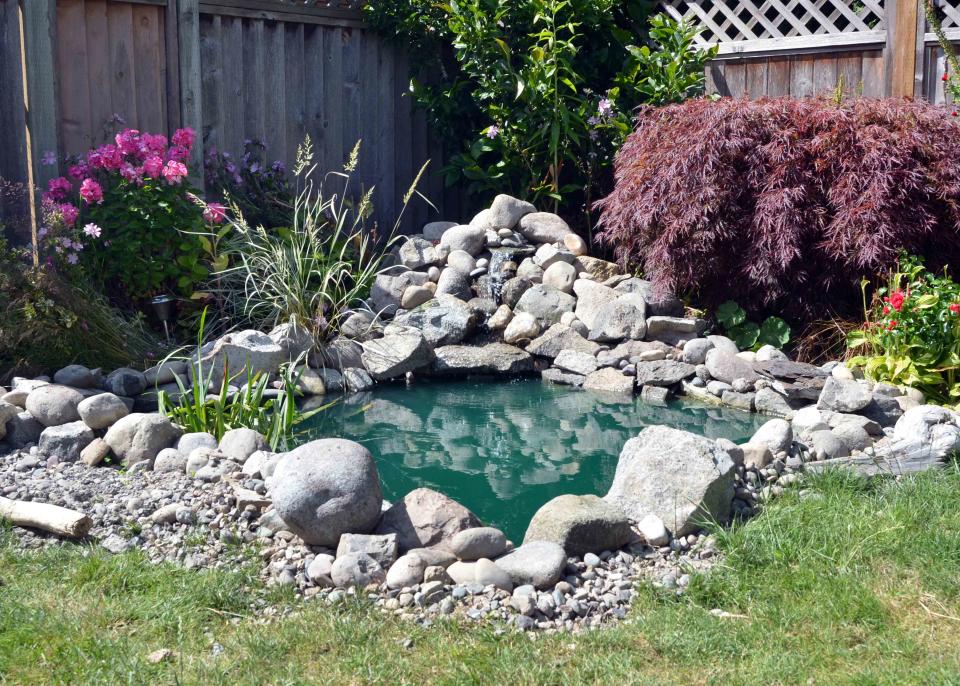Water Gardens Are a Dreamy Addition to Any Yard—Here’s How to Make One
Gardening pros offer a step-by-step guide on how to make a beautiful water garden.

Anthony Rosenberg/Getty Images
Any garden will invigorate your senses and help you feel at one with the earth around you, but there’s something very special about a water garden, in particular. Whether a serene pond or cascading fountain, water gardens effortlessly blend striking flora with aquatic life, ushering in a sense of serenity for both you and local wildlife.
“When I think of a water garden, I think of peace,” says gardener Madeline Hooper, host of the PBS show GardenFit. “It’s a restful experience for the senses and visually beautiful.” We’re teaching you how to create a water garden in your own backyard, including suggestions for the best types of flowers and decorative details to incorporate, and tips on how to keep it clean.
Meet Our Expert
Madeline Hooper, gardener and host of the PBS show GardenFit
Teri Valenzuela, natural science manager at Sunday
What Are Water Gardens?
Water gardens are landscaping features that involve some form of water, such as a pond, stream, or fountain. They’re typically integrated with plants that thrive in these aquatic environments, and can also serve as a habitat for wildlife—like ducks, fish, and pollinators—to enjoy. Of course, water gardens provide a wonderful sense of serenity not just with their vibrant color palettes and beautiful textures, but with the soothing sound of moving water.
Related: 20 Easy Landscaping Ideas to Add Instant Curb Appeal to Your Home
How Do You Make a Water Garden?
Keen on building your very own water garden? Follow this step-by-step guide.
Step 1: Plan Your Design
First, determine whether you want to incorporate an above-ground fixture (like a fountain or small “pond”) or want to DIY your own underground. The former is far easier, but the latter is completely doable. From here, choose a location that’ll fit the water garden size you prefer. Ideally, the location should be level and have access to both sunlight and electricity.
If excavating, make sure the area below is free from underground utilities; call your service provider and request they mark any lines. Next, dig the pond or stream so it’s your desired depth and shape.
Step 2: Lay a Flexible Pond Liner
If excavating, place a flexible pond liner over the dugout area, ensuring it covers the entire bottom and sides with some overhang so the liner doesn’t fall back into the water. Smooth out wrinkles and secure the edges. The easiest way to secure your liner is with an anchor trench configuration that outlines the shape of the pond or stream.
Step 3: Add a Filtration System
Above-ground water features typically have built-in filtration systems. DIY projects won’t, so you’ll need to purchase and install one.
“Water gardens need proper filtration to stay clean, avoid the formation of algae, and prevent the population of mosquitos,” Hooper says. “Ideally, a continuous-cleaning filter system is best.” It also keeps the water clear and prevents bad smells.
Step 4: Decorate with Rocks and Gravel
Arrange rocks and gravel around the pond's edges to help create a more rugged and natural look. As a bonus, strategically placed rocks and gravel can further help stabilize the pond liner and prevent erosion. Plus, these natural elements offer cozy hiding spots for small aquatic creatures.
Step 5: Add Water-Loving Plants
Now for the fun part: plants! “Moisture-loving plants can also serve as habitats and food sources for local wildlife,” says Teri Valenzuela, natural science manager at Sunday.
She adds, “Depending on your location, look for certain species of sedges, ferns, lilies, irises, horsetails, hibiscus, and milkweeds.” Some additional plants to consider include papyrus, lotus, horsetail rush, and alocasias.
Related: How to Grow and Care for Lily Flowers
Step 6: Incorporate Cool Features
You can infuse your water garden with a bit of theatrics, as well. These include features such as bridges, which Hooper says are “truly inviting” and allow you to look down into larger bodies of water to view the flora and fauna.
Other elements could include a small waterfall, bird bath, or even koi fish. However, Valenzuela notes that some of the best elements are the ones you can’t install: local wildlife like ducks, birds, bees, and butterflies that happily utilize the water. “The sound of moving water is an encouraging cue for local wildlife to come stop by,” she says.
Related: 26 Outdoor Decor Ideas to Turn Your Yard Into a Relaxing Oasis
Step 7: Maintain It
Proper sanitation and upkeep are crucial to avoiding mold or mildew, Valenzuela says. You’ll want to monitor water quality, clean the filters, remove debris, and trim plants as needed.
For more Real Simple news, make sure to sign up for our newsletter!
Read the original article on Real Simple.

